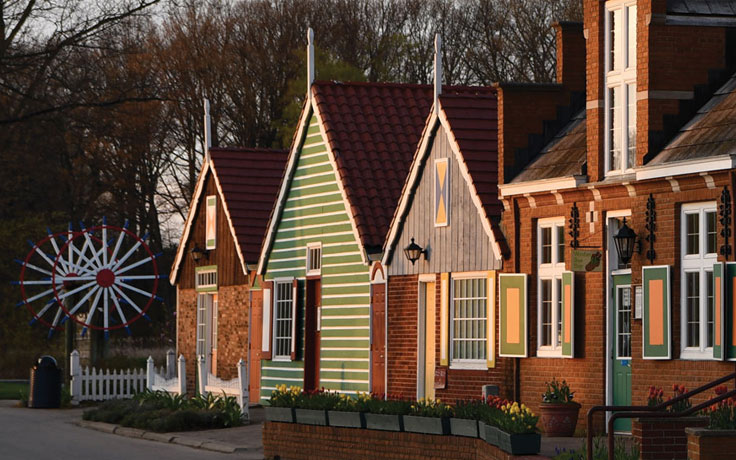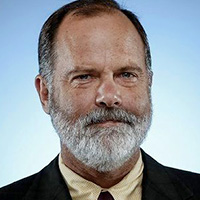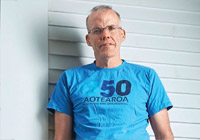JAMES FALLOWS WENT TO WASHINGTON to work for President Carter. He stayed to become one of the most influential, admired and emulated journalists of his era. Writing for decades in books and for the Atlantic, Fallows has created a body of work devoted to analyzing real life, mostly in the United States but also in places such as China, Australia, Great Britain and Africa.
His latest book is a collaboration with his wife, Deborah Fallows. It chronicles their journeys across and around the United States since the election of Donald Trump. Our Towns: A 100,000-Mile Journey Into the Heart of America describes communities finding their ways forward, defying ideological expectations and discovering common purpose. It is a surprisingly upbeat assessment, one strikingly at odds with the news from Washington, and it suggests some hope for an American future.
Fallows and Blueprint editor-in-chief Jim Newton spoke by Skype in March, Fallows from his office overlooking the Watergate complex in Washington, D.C., Newton from Pasadena. Their conversation follows:
The Fallows-Newton conversation
Blueprint: How did you set out to do this book? What prompted you to take it on?
James Fallows: There were two impulses that are almost amusing to look back on. My wife and I had been living in China for about four years, where we were based first in Beijing and then Shanghai, and we tried to spend as much time as we could on the road, because there is such a difference between how things look in a city of 25 million people and how they look in a city of 8 million people, or a smaller place out in the hinterlands. So we have a long history of liking to be on the road and seeing what you don’t know until you show up.
The other is an increasing awareness of how the national media, just by default, report on a half dozen cities and only schematically on the other 20,000 cities or rural life. So we just wanted to see what in fact people thought was going well and poorly in Sioux Falls or Holland, Mich.
We had no particular hypothesis to try out when we began this. It was more that “I’ve never been to Sioux Falls, S.D. I wonder what it’s like there.” Over time, there was sort of an accumulating hypothesis, which was the contrast between how people were feeling about the parts of the U.S. they experienced directly versus the parts they read about, and the contrast between national-level dystopia … and the kinds of practicality we saw in very different places around the country.
BP: Did you visit places that you did not end up using in the book, places that didn’t seem to be working well?
JF: We visited a lot more places than we wrote about, but it was a matter of depth of interviewing as opposed to tone and what was going on there. For most of the places we wrote about, we had been there for at least two weeks, which is not long enough to have a deep sense of what’s going on, but it’s a lot more than being there for a day. … We probably stopped in about 60 to 75 places, and we wrote about 25 of them.
As this went on for over three to four years, we started deliberately looking for places we knew were more troubled — San Bernardino, for example, or Erie, Pa., or West Virginia, or Mississippi.
On the one hand, this was no one’s idea of a controlled, scientific survey, with random, blind trials. But we did deliberately go to places … with worse unemployment rates, with worse racial tensions, with worse recent shocks, and see if they, too, are having some kind of cohesion. Most places we went felt as if they were moving forward, as opposed to not.
BP: I was really struck, and I’m sure many people have been in reading your book, by what seems to be a fundamental optimism that comes through. And I must say, that’s not what I usually read about America these days.
JF: First, I’ll give you an unlikely data point … AEI [the American Enterprise Institute], the big conservative think tank, has been running a huge mood-of-the-country survey … and they found, reassuringly to us as reporters, that people felt really bad about the country … but most people, if you ask them about the area where they actually live, felt that its direction was positive. This was true across regions, across racial lines, across income groups, etc. And it’s from different starting points. The starting point in Charleston is different from the starting point in Palo Alto, but the direction was similar.
We have now seen enough places and heard from enough people, thousands of people, to contend that this is actually true, that most of the country feels as if life is more manageable, and solutions are more practical, within their own sphere of knowledge than in the rest of the country.
BP: It reminds me a little of polls historically in which Congress would poll very badly, but individual members of Congress were fairly well-liked at home.
JF: Yes. I have been tempted over the decades to write off that kind of finding, only because politicians, by definition, are supposed to be likable. We can think of some obvious exceptions.
BP: Well, it’s considered a starting point, but not always …
JF: But people’s sense of their own communities depends on whether they feel some tangible improvement.
Now, the national economy, through this whole time, has been recovering from national shocks. But we’ve been to enough different places at enough different points along the scale with enough things happening to them to think that this actually is an underappreciated trend of the times, of people being able to work for improvement locally more than nationally.
BP: And you experienced this in communities that are ideologically very far apart, Greenville, S.C., and Burlington, Vt., to name two that may be at the extremes. Did you find differences in terms of the search for local solutions based on the underlying ideologies of these communities?
JF: Somewhat. … Almost everywhere we went, faith communities were important parts of social cohesion. They were important as gathering places. They were crucially important for settling immigrants and refugees. They often were involved in addressing homelessness and opioids.
The main reason we didn’t write that much about them … is that in many places they’ve become aligned with national politics, which is something that we were trying to avoid. In the Deep South, for example, they were a more obvious presence than in, say, Vermont.
So in places that are more conservative in national politics, we did see a more obvious role for faith organizations, but the more general trend was that we did see similar institutions playing similar roles despite alignment on national politics. Libraries, for example, are really a happening thing all over the place. And community colleges also are a happening thing. YMCAs or Y’s are becoming big. Public-private partnerships we saw very distinctly, and strong mayors’ offices.
BP: I’m glad you mentioned public-private partnerships. I’ve spent my whole professional life hearing about these partnerships, and I must admit that I’ve sort of tuned it out. What did you find out there that may surprise people like me who’ve gotten tired of this slogan and idea?
JF: I’m speaking to you from Washington, and I first came here back in the ‘70s to work for Jimmy Carter. I’ve spent about half of my time since then in Washington and about half in other places. The Washington part of my formation has created great skepticism about public-private partnerships be- cause it was sort of a code word for payola, the sweetheart deal.
That’s what we think of in D.C., and it was really surprising to me … to see how: 1) sincere and not eye-rolling people at the local level were about this; and 2) what a tangible thing it was.
[Take, for example] Holland, Mich., home base of Betsy DeVos, which is a very strong manufacturing community. It’s a big auto industry supplier, and today it’s majority Latino. DeVos’ father, Edgar Prince, was a very successful private businessperson, and he worked with the city government of Holland to fund their so-called “snow-melt” system [essentially, an underground heating system that keeps Holland streets free of snow and ice during the winter]. … It made this huge, transformative difference, and it was a genuine public-private partnership. He put up the original money if the city would pay the operational cost year by year. They’ve done that for very low cost by bleeding waste heat from their power plant. …
From a logical point of view, you can see that there’s a whole array of problems, from educational reinvention to sustainability to almost any challenge you can think of, where the assets and the expertise and the organizational ability of private companies could, in theory, be matched with the authority and the legitimacy and the reach of public governments to do something that’s better than either could do on their own.
BP: How does boosterism play into this, and how is it something more than just vanity or something disreputable?
JF: On the one hand, let us stipulate that we are from the country that coined the term Babbitry and where Mark Twain wrote about the boosters he was lampooning. Side note: Everything that’s worth dealing with in life is contradictory, and this is one of those things in the U.S., where there’s always been a strong strain in life of the booster, the fraud, the Music Man, the phony, the huckster. It tells you something that there are so many terms in American English for this.
BP: It’s like the Eskimos having 100 words for snow.
JF: Yes, that tells us something. There is something that we properly are wary of. On the other hand, there is something we ended up calling “civic patriotism,” which I would define in two particular ways: One is a sense of responsibility for the world beyond your front door, that where you live is not just where you live … but you have some organic connection to what it looks like, how other people are doing there, whether it’s improving or not. The other is a willingness to think longer term, to begin projects that you personally might not see the benefits from, that even your children might not see the benefits from. …
And there’s one other element of civic patriotism. We recognize at the national level that there is such a thing as a national myth in the good and bad connotations of “myth.” The American myth of equal opportunity is largely myth in that it doesn’t happen, but it’s useful mythos, too, in giving people something that we should aspire to.
The American Dream is both a falsity and an ideal. This has its local ramifications, too. The California Dream is a real thing, I say as a son of San Bernardino County. The American Dream is, too.
BP: Let me ask you about newspapers. You have a lot of discussion about the role that local journalism plays in some of these communities, and yet that’s obviously changing — probably changing somewhat even since the time you visited some of these places. How do the radical changes in the media environment affect life in these communities?
JF: This is a genuine problem, crisis, emergency — whatever synonym we like for something we have to deal with. … The reason it’s a problem is that just as communities need a civic story and they need civic patriots, they also need some way to be connected with information. That’s what newspapers have historically done. …
While the big shift over the last generation is, of course, the rise of the Internet, vacuuming up the classified ad market and other previously stable advertising markets for the printed press in general, the really disastrous accelerant right now is the shift in ownership, the private equity/ venture capital model, which, by definition, brings these papers into a very speeded-up, vicious cycle. They’ve shrunk to [increase] their profit margin, their shrinkage makes them less and less valuable, they shrink further, and it’s just a disaster.
The countervailing wave now is to find alternative ownership models. Historically, the times when serious news has been a viable business are rarities. Post-World War II was an exception. Some of the newspaper wars at the turn of the century were an exception. But generally, serious news has required some other host body to support it.
When I was a kid in Redlands, the L.A. Times was like a thousand pages thick. It was the only way that you could reach that whole market. You couldn’t get a New York Times or a Wall Street Journal.
BP: I remember Shelby Coffey, its editor, once saying that there were more words in a Sunday Los Angeles Times than in the New Testament.
JF: It is true. When I was a kid, we got the L.A. Times, the San Bernardino Sun, the Redland Daily Facts. All these were viable papers. So you’ve got this technological shift, but the accelerant is this ownership shift.
There has to be some experimentation, just as 120 years ago you had different business models to support universities and museums and arts companies and ballets. That’s why we know the names of Rockefeller and Carnegie and Ford and Mellon and Frick. They were applying the fortunes of that era to shore up things that did not have a normal business space. Local journalism may be partnering with local universities, it may be nonprofit models …
BP: In the absence of those new models, what is the cost that communities pay if journalism suffers?
JF: The cost is that it’s harder to do things that are good, and it’s easier to let things happen that are bad. Whether you’re trying to get a new school going, or integrate a new ethnic group that’s arrived, or invest in a new park, or have a downtown renovation project — everything that makes these towns more attractive in the long run requires some initial disruption or dislocation, and local press has been a way to deal with that, to make that possible.
About making it easier for bad things to hap- pen, there’s the obvious level of just corruption, or special deals, or people who are left behind, or crime, or addiction, or whatever.
So the cost is: All the things that are encouraging in local life are less likely to happen, the things that are discouraging are more likely.
BP: You write a lot about the Gilded Age, and draw a number of comparisons from our current time to that period in our history. What would you imagine being the lessons of this period that would help us as we move out of this Gilded Age?
JF: One of my many embarrassing secrets is that the only thing I read anymore is either fiction from the original Golden Age or nonfiction about it. On the fiction front, Theodore Dreiser could be writing about America of this moment — Sister Carrie and American Tragedy, The Titan and The Financier, they all could have been ripped from the headlines, as we say.
And I’ve been reading just [recently], a book I read in college long ago: Looking Backward, by Edward Bellamy. This was the second best-selling book of the 1800s in the U.S. … The first was Ben-Hur.
It was written in the late 1880s. It’s about a guy who falls into a trance in 1887 and wakes up in the imagined year 2000, when all of the world’s problems have been solved. It’s this fantasy of how they got through all the things that were horrible. It’s an interesting thought experiment.
If you look at the original Gilded Age, almost every problem we’re having now has a counterpart there — rapid new fortunes and rapid loss of traditional means of livelihood, political corruption and political mistrust, etc.
Looking back, we know there was a nascent good side. All around the country, [there were] these initially disconnected local reform movements — California and its Good Government movement, Jane Addams and her civic involvement movement in Chicago, the women’s rights movement, down through 50 other reform movements that came up during that time. The positive version of the comparison is to say: 1) Could we recognize that something similar might be going on now? 2) Can we learn about ways in which their efforts were pooled a century ago to lead to an Age of Reforms? And 3) Is it possible to do it without two world wars and a depression?
You could call that cherry-picking. Obviously, history doesn’t ever exactly repeat, but there are enough similarities to be of use as an instructive model.

























